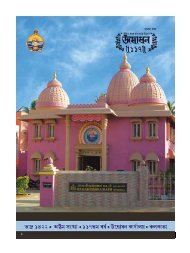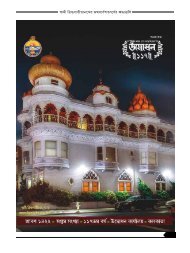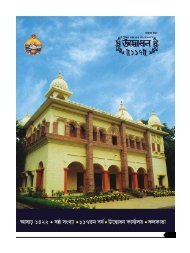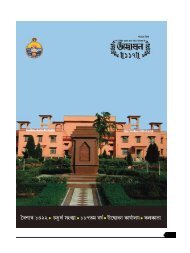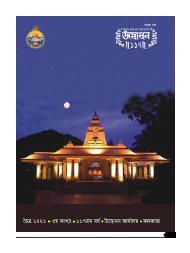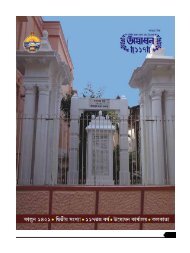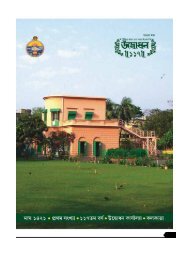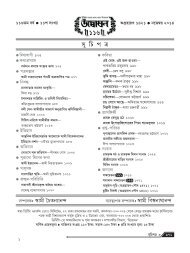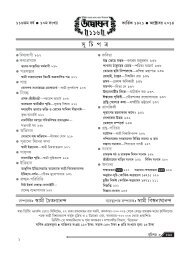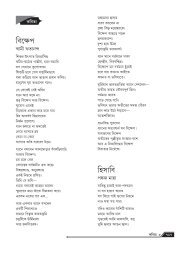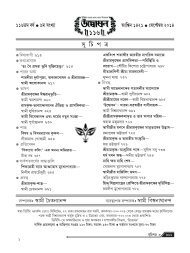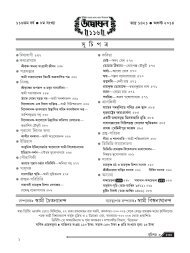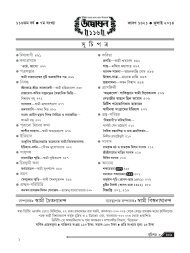June 2014
Udbodhan Magazine
Udbodhan Magazine
Create successful ePaper yourself
Turn your PDF publications into a flip-book with our unique Google optimized e-Paper software.
academic <br />
, —<br />
- <br />
? <br />
? , <br />
- academic ? ,<br />
, <br />
<br />
, <br />
- ‘ ’<br />
(Aryan invasion) <br />
, <br />
, <br />
(hypothesis)- []<br />
<br />
The Historiography of the Concept of ‘Aryan’—Romila<br />
Thapar, eassy printed in ‘India : Historical Beginnings and the<br />
Concept of Aryan’, National Book Trust, New Delhi, 2007,<br />
p. 1<br />
Origin of Myths and the Early Indian Historical Tradition—<br />
Romila Thapar, essay printed in ‘Cultural Pasts’, Oxford<br />
University Press, Delhi, 2000, pp. 754-781<br />
<br />
, ‘’ <br />
‘history’- <br />
‘-’- <br />
‘’ ( ‘history’ ) <br />
- ‘Time as a Metaphor of<br />
History : Early India’—Romila Thapar. <br />
‘History and Beyond’ (Oxford<br />
University Press, New Delhi, 2011)<br />
The Historiography of the Concept of ‘Aryan’, p. 2<br />
Ibid.<br />
Ibid., p. 3<br />
For details see Indian and the Romantic Imagination—H.<br />
Drew, Oxford University Press, New Delhi, 1987<br />
For details see The Aryan Myth—L. Poliakov, Sussex<br />
University Press, 1974<br />
The Historiography of the Concept of ‘Aryan’, p. 7<br />
Ibid.<br />
H. H. Risley <br />
‘The People of India’ (Thacker Spink & Co., 1908)<br />
Black Athena—M. Bernal,<br />
New Brumswick, Rutgers University Press, 1987<br />
- - <br />
- <br />
—(1) Lectures on<br />
the Science of Language (1862), (2) India : What Can it<br />
Teach Us? (London, 1883), (3) Biographies of Words and<br />
the Home of the Aryans (Oxford, 1888) and (4) Rigveda<br />
Samhita (reprinted in 1983 from Krishnadas Akademy,<br />
Varanasi)<br />
The Historiography of the Concept of ‘Aryan’, p. 10<br />
“...Aryan in scientific language is utterly inapplicable to<br />
race. It means language and nothing but language...” : this<br />
statement is quoted by Romila Thapar from ‘Auld Lang Syne’<br />
by Max Muller. See The Historiography of the Concept of<br />
‘Aryan’, p. 10<br />
<br />
Biographical Essays (Oxford<br />
University Press, 1884) , ‘’ ‘-<br />
’ (<br />
) —“...Ram<br />
Mohun Roy was an Arya belonging to the south-eastern<br />
branch of the Aryan race and he spoke an Aryan language,<br />
the Bengali.... We recognise in Ram Mohun Roy’s visit to<br />
England the meeting again of the two great branches of the<br />
Aryan race, after they had been separated to long that they<br />
had lost all recollection of their common origin, common<br />
language and common faith.” See Romila Thapar’s The<br />
Historiography of the Concept of ‘Aryan’, pp. 10-11<br />
The Historiography of the Concept ‘Aryan’, p. 11<br />
<br />
‘’, , , , <br />
-<br />
Selected Writings of Jyotiba<br />
Phule—G. P. Deshpande, Tulika, New Delhi, 2002<br />
Jyotiba Phule : An Incomplete<br />
Renaissance—G. Omvedt, CSS, Surat<br />
- —(1) Orion<br />
or Researches into the antiquity of the Vedas (Tilak Press,<br />
Poona, 1893), (2) The Arctic Home in the Vedas (Tilak<br />
Bros., Poona, 1903)<br />
“...in the advent<br />
of the English nation in India we see a reunion of parted<br />
cousins, the descendants of two different families of the<br />
ancient aryan race.” —Keshab Chunder<br />
Sen’s Lectures in India, Navavidhan, Calcutta, 1923, p.<br />
323<br />
–




